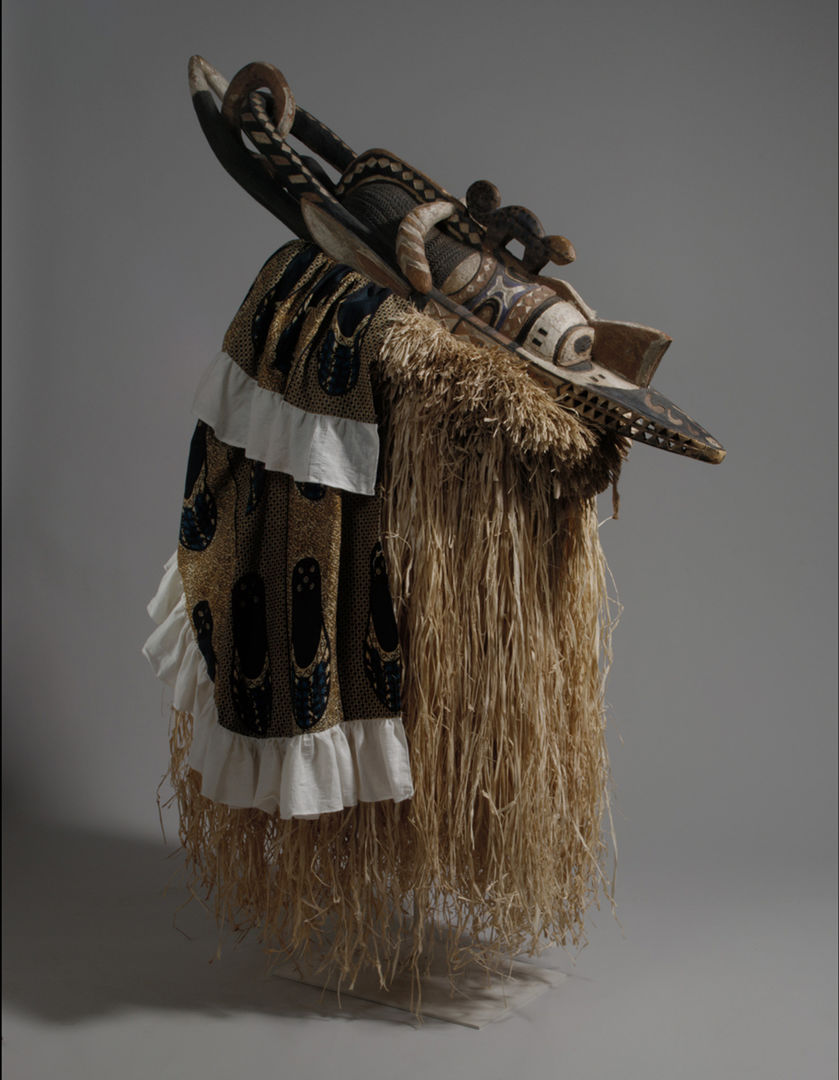Animal-Inspired Masks and Masquerades

Banda mask, 19th–20th century. Guinea. Nalu Wood, pigment, raffia, modern textile, 12 13/16 x 52 1/2 in. (32.5 x 133.4 cm). The Metropolitan Museum of Art, New York, The Michael C. Rockefeller Memorial Collection, Purchase, Nelson A. Rockefeller Gift, 1964 (1978.412.307)
Collection Area: African Art
Subject Areas: English Language Arts, Science, Visual Arts, World History
Grades: Elementary School
Topics/Themes: Art and the Environment, The Art of Belief, Animals in Art
Goals
Students will be able to:
- make connections between the art and environment of Guinea;
- link the physical structures of animals with their function; and
- recognize the cultural context of the Banda mask.
National Learning Standards
English Language Arts
NL-ENG.K-12.3 Evaluation Strategies
NL-ENG.K-12.4 Communication Skills
NL-ENG.K-12.9 Multicultural Understanding
Science
NS.K-12.3 Life Science
Visual Arts
NA-VA.K-12.2 Using Knowledge of Structures and Functions
NA-VA.K-12.3 Choosing and Evaluating a Range of Subject Matter, Symbols, and Ideas
NA-VA.K-12.4 Understanding the Visual Arts in Relation to History and Cultures
NA-VA.K-12.6 Making Connections between Visual Arts and Other Disciplines
World History
NSS-WH.5-12.7 Era 7: An Age of Revolutions, 1750–1914
NSS-WH.5-12.8 Era 8: A Half-Century of Crisis and Achievement, 1900–1945
NSS-WH.5-12.9 Era 9: The 20th Century Since 1945: Promises and Paradoxes
Common Core State Standards
English Language Arts
CCSS.ELA-Literacy.CCRA.SL.1 Prepare for and participate effectively in a range of conversations and collaborations with diverse partners, building on others' ideas and expressing their own clearly and persuasively.
CCSS.ELA-Literacy.CCRA.SL.2 Integrate and evaluate information presented in diverse media and formats, including visually, quantitatively, and orally.
CCSS.ELA-Literacy.CCRA.SL.4 Present information, findings, and supporting evidence such that listeners can follow the line of reasoning and the organization, development, and style are appropriate to task, purpose, and audience.
Questions for Viewing
- Take a moment to look closely at the human and animal features on this mask. What do you notice?
- Three animals found in Guinea are the crocodile, antelope, and chameleon (share and examine photographs of these animals). Which details on this mask might be inspired by a crocodile? How do these features help the animal survive in the wild? (Repeat for other animals.)
- What other animals might have inspired this artist?
- While today masks like this one are danced for entertainment on national holidays and special occasions in Guinea, society elders once called upon Banda—the character the mask represents—to protect the community. If you were going to create a mask designed for protection, what other animal features would you include? Why?
Activity
Activity Setting: Museum
Materials: Image of a crocodile, antelope, and chameleon
Subject Areas: Dance, Science
Duration: 30 minutes
Animals inspire not only the artists who make Banda masks but also the dancers who wear them. Imagine the dancer in action. One animal on the mask is a crocodile. Use your head, chest, and arms to show how the jaw of a crocodile might move. (Repeat for other animals.) How might we transition from the crocodile to the antelope? (Repeat for other animals.) Put the movements together in one fluid dance. Which movements would be most challenging to do while wearing the mask?
Resources
"Banda Mask [Baga peoples; Guinea] (1978.412.307)." In Heilbrunn Timeline of Art History. New York: The Metropolitan Museum of Art, 2000–. (October 2006)
Clarke, Christa. The Art of Africa: A Resource for Educators. New York: The Metropolitan Museum of Art, 2006. Download the resource.
Pre-Visit Guide for Teachers: The Art of Africa (PDF)
Roberts, Allen F. Animals in African Art: From the Familiar to the Marvelous. New York: The Museum for African Art, 1995.
Objects in the Museum's Collection Related to this Lesson
Serpent headdress (A-Mantsho-ña-Tshol), 19th–20th century. Guinea, Niger River region, Baga peoples. Wood, pigment 68 1/2 x 6 5/8 x 17 in. (174 x 16.9 x 43.2 cm). The Metropolitan Museum of Art, New York, The Michael C. Rockefeller Memorial Collection, Bequest of Nelson A. Rockefeller, 1979 (1979.206.101)
Male and female antelope headdresses (Ci wara kun), 19th–20th century. Mali, Segou region. Bamana Wood, metal bands; 1978.412.435: H. 35 3/4 in. (90.8 cm); 1978.412.436: H. 28 in. (71.1 cm). The Metropolitan Museum of Art, New York, The Michael C. Rockefeller Memorial Collection, Gift of Nelson A. Rockefeller, 1964 (1978.412.435, 1978.412.436)
Author: Claire Moore (The Metropolitan Museum of Art, 2010)